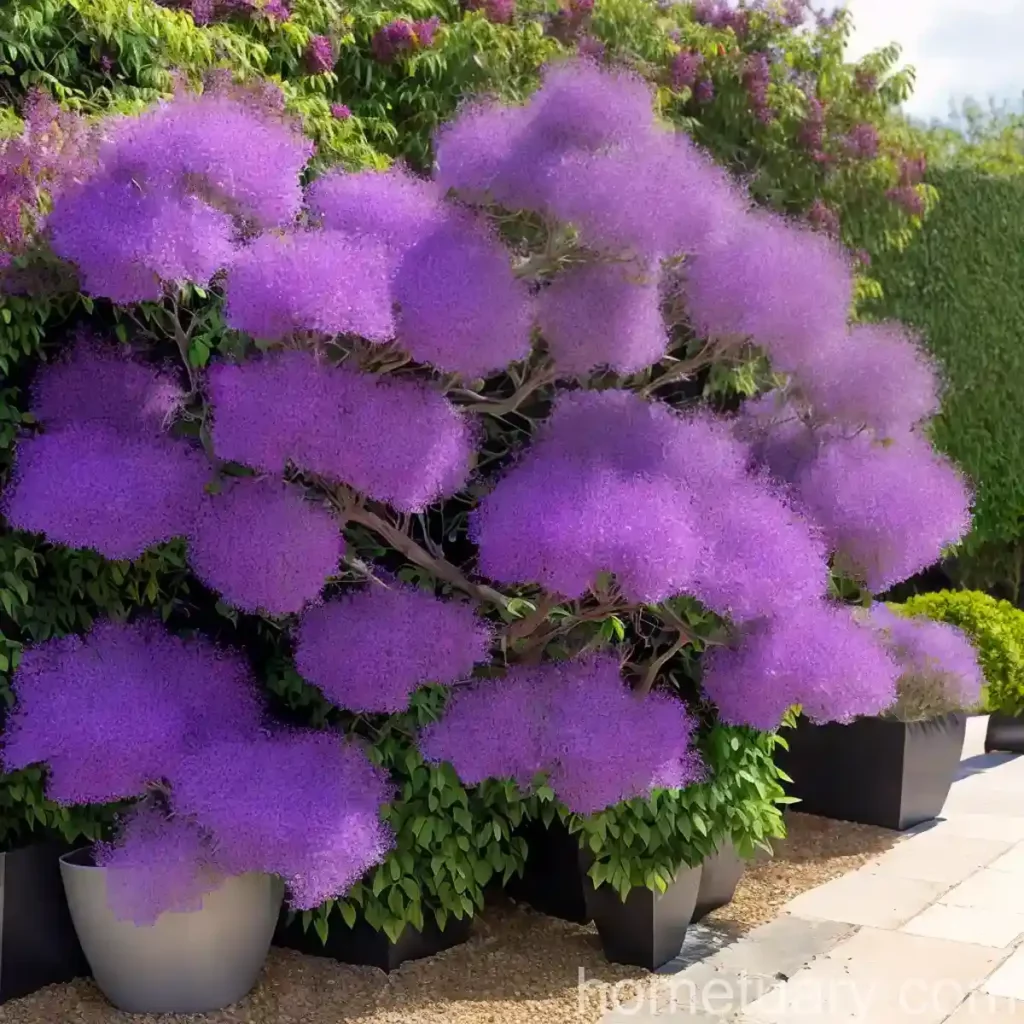The Fascinating World of Smoketree (Cotinus coggygria ‘Royal Purple’)
Introduction
Welcome to the exciting world of smoketrees, particularly the captivating Cotinus coggygria ‘Royal Purple’. These exquisite ornamental shrubs are cherished for their stunning foliage, delicate flowers, and impressive landscape presence. In this comprehensive guide, we will delve into the culture, uses, care, and other essential aspects of smoketrees, with a specific focus on the Royal Purple variety.
What is a Smoketree (Cotinus coggygria ‘Royal Purple’)?
The smoketree, scientifically known as Cotinus coggygria, is a deciduous shrub with a unique, smoky appearance due to its clusters of small, fuzzy, hair-like hairs that resemble smoke. The ‘Royal Purple’ cultivar stands out for its striking, deep purple foliage, which adds a dramatic touch to any garden or landscape.
Key Takeaways – Smoketree (Cotinus coggygria ‘Royal Purple’)
To fully appreciate and understand this mesmerizing shrub, let’s dive into its key characteristics, including its cultural preferences, usage, care tips, and more.
Culture
The culture of the Royal Purple smoketree revolves around providing the ideal environment for its growth and development. This encompasses various factors such as water, sunlight, fertilizer, soil, and pruning techniques.
- Uses
- Ornamental: The Royal Purple smoketree serves as a captivating ornamental plant, enhancing the visual appeal of gardens, landscapes, and floral arrangements.
-
Landscape Design: Its vibrant foliage and unique smoky appeal make it a desirable choice for landscape designers seeking to add depth and color to outdoor spaces.
-
Water
-
The smoketree generally prefers well-drained soil and moderate watering, especially during its establishment phase. Once established, it exhibits good drought tolerance.
-
Sunlight
-
It thrives in full sun to partial shade, with the ideal balance contributing to the best foliage coloration.
-
Fertilizer
-
When it comes to fertilizer, a balanced, slow-release fertilizer in spring can help maintain the shrub’s vigor and coloration.
-
Soil
-
Well-drained, slightly acidic to neutral soil is ideal for the Royal Purple smoketree. It’s important to avoid waterlogged conditions to prevent root rot.
-
Pruning
- Proper pruning is essential for maintaining the smoketree’s shape, controlling its size, and promoting a healthy framework. Pruning in late winter or early spring before new growth emerges is recommended.
Propagation
The propagation of the Royal Purple smoketree can be achieved through various methods such as hardwood cuttings, softwood cuttings, and seeds. Each approach offers a unique set of advantages and considerations.
Container Popularity
Given its compact size and ornamental appeal, the Royal Purple smoketree is well-suited for container cultivation, adding a touch of elegance to patios, balconies, and other outdoor spaces.
Common Diseases
While generally resilient, smoketrees may be susceptible to certain diseases, including fungal infections and leaf spot. Adequate cultural practices and vigilant monitoring can mitigate these risks.
Disease Diagnosis
The timely identification and diagnosis of common smoketree diseases are crucial for implementing targeted management strategies and preserving the shrub’s health and vigor.
Common Pests
Pests such as aphids, caterpillars, and spider mites may occasionally pose challenges to the Royal Purple smoketree. Regular monitoring and integrated pest management methods are essential for pest control.
Botanist’s Tips
Cultivar Characteristics
- The Royal Purple smoketree exhibits an enchanting blend of deep purple foliage, which intensifies in color as the season progresses, creating a remarkable visual impact in outdoor settings.
Care Guide
- Providing adequate sunlight, well-drained soil, and moderate watering are key elements of successful smoketree care, contributing to optimal growth and flowering.
Pruning Tips
- Pruning should focus on removing dead or damaged branches, shaping the shrub, and promoting adequate airflow within the canopy to prevent disease development.
Colors
- The mesmerizing hues of the Royal Purple smoketree’s foliage range from deep purple to rich burgundy, adding dynamic coloration to the landscape.
Landscape Ideas
- In landscape design, the smoketree serves as a versatile element, offering vivid foliage contrast, structural interest, and seasonal variation.
Propagation Techniques
- Successful propagation of the Royal Purple smoketree can be achieved through strategic timing, proper cutting selection, and optimal environmental conditions.
Smoketree Maintenance
- Regular maintenance, including monitoring for pests and diseases, fertilizing, and pruning, is crucial for sustaining the health and vitality of the smoketree.
Benefits
- The Royal Purple smoketree contributes to the visual allure of gardens and landscapes, enhances biodiversity, and offers potential medicinal and folklore significance.
Fun Facts
- The smoketree (Cotinus coggygria ‘Royal Purple’) belongs to the Anacardiaceae family, which also includes cashews, mangos, and poison ivy.
- Its unique smoky appearance arises from the wispy, elongated strands of individual hairs that form the floral clusters.
- The smoketree has a rich cultural history, with various ancient traditions associating it with mystical and symbolic meanings.
Links to External Resources
For further exploration and information on the fascinating world of smoketrees, the following external resources provide valuable insights and guidance:
- Royal Purple Smoketree – Plant Profile and Landscaping Ideas
- Cotinus coggygria ‘Royal Purple’ – Cultivation Guidelines and Care Recommendations
- Growing Smoketrees in Containers – Tips for Successful Cultivation
- Common Diseases of Smoketrees and Management Strategies
- Pest Control for Smoketrees – Effective Management Approaches
In conclusion, the smoketree, particularly the captivating Royal Purple variety, stands as a botanical treasure, offering a harmonious blend of aesthetic appeal, cultural significance, and horticultural interest. Embracing the art of cultivating and caring for these ornamental shrubs ensures a vibrant and dynamic landscape, enriched by nature’s captivating palette of color and form.
What are your thoughts on the Royal Purple smoketree? Share your experiences and insights in the comments below!















